Testing ASTER and Sentinel-2 MSI Images to Discriminate Igneous and Metamorphic Rock Units in the Chadormalu Paleocrater, Central Iran
IF 2.1
4区 地球科学
Q3 REMOTE SENSING
引用次数: 2
Abstract
Abstract In the last fifty years, satellite images have been used to map the Earth’s surface at a variety of scales. Two satellite multispectral sensors (Sentinel-2 MSI and ASTER) have great utility for lithological discrimination in areas of good rock exposures. This study was conducted in order to test the ability of these sensors to discriminate igneous and metamorphic lithologies in the Chadormalu paleocrater and evaluate the image types and processing methodologies. The MNF (Minimum Noise Fraction) transform, Mathematical Evaluation Method (MEM), Spectral Angle Mapper (SAM), Mixture Tuned Matched Filter (MTMF), and band ratios were performed on near and short wave infrared ASTER and Sentinel-2 bands. Comparison of the results from several methods demonstrates that the MEM method can detect lithological units with very low false detection and better matching with ground truth data. Moreover, this study indicates that the results produced by the MEM algorithm on Sentinel-2 MSI data are more accurate than the results produced with ASTER data in the same area. Therefore, the MEM algorithm seems to be well suited for image classification involving multispectral databases such as ASTER and Sentinel-2 images.测试ASTER和Sentinel-2 MSI图像以区分伊朗中部Chadormalu古火山口的火成岩和变质岩单元
在过去的五十年里,卫星图像被用于绘制各种尺度的地球表面。两颗卫星多光谱传感器(Sentinel-2 MSI和ASTER)在岩石暴露良好的地区具有很大的岩性识别作用。为了测试这些传感器在Chadormalu古陨石坑中区分火成岩和变质岩的能力,并对图像类型和处理方法进行评估。在近、短波红外ASTER和Sentinel-2波段分别进行了MNF (Minimum Noise Fraction)变换、数学评价法(MEM)、光谱角映射器(SAM)、混合调谐匹配滤波器(MTMF)和带比分析。几种方法的结果对比表明,MEM方法可以较好地检测岩性单元,误检率极低,与地面真实数据的拟合性较好。此外,本研究表明,在相同区域,Sentinel-2 MSI数据上MEM算法得到的结果比ASTER数据得到的结果更准确。因此,MEM算法似乎非常适合于涉及ASTER和Sentinel-2等多光谱数据库的图像分类。
本文章由计算机程序翻译,如有差异,请以英文原文为准。
求助全文
约1分钟内获得全文
求助全文
来源期刊

Canadian Journal of Remote Sensing
REMOTE SENSING-
自引率
3.80%
发文量
40
期刊介绍:
Canadian Journal of Remote Sensing / Journal canadien de télédétection is a publication of the Canadian Aeronautics and Space Institute (CASI) and the official journal of the Canadian Remote Sensing Society (CRSS-SCT).
Canadian Journal of Remote Sensing provides a forum for the publication of scientific research and review articles. The journal publishes topics including sensor and algorithm development, image processing techniques and advances focused on a wide range of remote sensing applications including, but not restricted to; forestry and agriculture, ecology, hydrology and water resources, oceans and ice, geology, urban, atmosphere, and environmental science. Articles can cover local to global scales and can be directly relevant to the Canadian, or equally important, the international community. The international editorial board provides expertise in a wide range of remote sensing theory and applications.
 求助内容:
求助内容: 应助结果提醒方式:
应助结果提醒方式:


